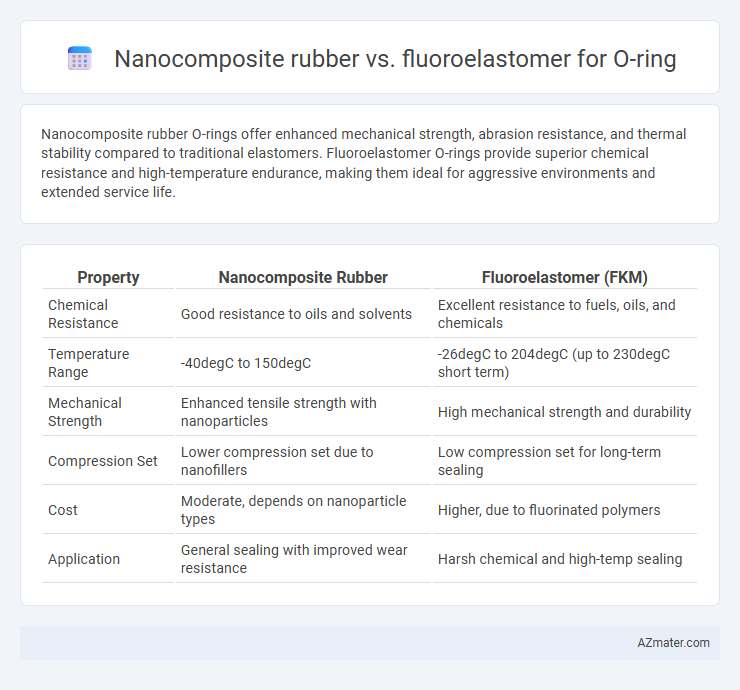Nanocomposite rubber O-rings offer enhanced mechanical strength, abrasion resistance, and thermal stability compared to traditional elastomers. Fluoroelastomer O-rings provide superior chemical resistance and high-temperature endurance, making them ideal for aggressive environments and extended service life.
Table of Comparison
| Property | Nanocomposite Rubber | Fluoroelastomer (FKM) |
|---|---|---|
| Chemical Resistance | Good resistance to oils and solvents | Excellent resistance to fuels, oils, and chemicals |
| Temperature Range | -40degC to 150degC | -26degC to 204degC (up to 230degC short term) |
| Mechanical Strength | Enhanced tensile strength with nanoparticles | High mechanical strength and durability |
| Compression Set | Lower compression set due to nanofillers | Low compression set for long-term sealing |
| Cost | Moderate, depends on nanoparticle types | Higher, due to fluorinated polymers |
| Application | General sealing with improved wear resistance | Harsh chemical and high-temp sealing |
Introduction to O-Ring Material Selection
Choosing the right O-ring material is critical for ensuring optimal sealing performance and chemical resistance in various applications. Nanocomposite rubber offers enhanced mechanical strength and thermal stability due to the dispersion of nanoparticles within the elastomer matrix, improving wear resistance and longevity. Fluoroelastomers, known for exceptional chemical inertness and high-temperature resistance up to 200degC, are preferred in aggressive environments where exposure to fuels, oils, and solvents is common.
Overview of Nanocomposite Rubber
Nanocomposite rubber combines polymer matrices with nanoscale fillers, enhancing mechanical strength, thermal stability, and chemical resistance significantly compared to traditional elastomers. These nanofillers create a reinforced network within the rubber, resulting in improved durability and superior performance under high-stress conditions in O-ring applications. Compared to fluoroelastomers, nanocomposite rubbers offer tailored properties through filler selection, balancing cost-effectiveness with enhanced physical and chemical resilience.
Overview of Fluoroelastomer (FKM)
Fluoroelastomer (FKM) is a high-performance synthetic rubber known for exceptional chemical, heat, and oil resistance, making it ideal for demanding O-ring applications in automotive, aerospace, and chemical processing industries. Compared to nanocomposite rubber, FKM exhibits superior durability in extreme environments, withstanding temperatures up to 200-250degC and exposure to aggressive fluids like fuels, oils, and acids. Its unique fluorine content provides low gas permeability and excellent sealing reliability, ensuring long service life and optimal performance in critical sealing solutions.
Mechanical Properties Comparison
Nanocomposite rubber O-rings exhibit superior tensile strength and abrasion resistance compared to fluoroelastomer counterparts, benefiting from enhanced filler dispersion and polymer matrix interaction. Fluoroelastomer O-rings excel in chemical resistance and high-temperature stability but generally demonstrate lower elongation at break and fatigue resistance than nanocomposite rubber variants. The integration of nanoscale fillers in nanocomposite rubbers significantly improves mechanical durability and resilience under dynamic sealing conditions.
Chemical and Thermal Resistance
Nanocomposite rubber O-rings exhibit enhanced chemical resistance due to the incorporation of nanofillers, which improve barrier properties and reduce permeation of aggressive chemicals. Fluoroelastomer O-rings provide superior thermal stability, maintaining integrity and elasticity at temperatures ranging from -40degC to 200degC, with exceptional resistance to oils, fuels, and solvents. When selecting O-ring materials for extreme environments, fluoropolymer-based fluoroelastomers offer a broader chemical compatibility and higher temperature tolerance compared to nanocomposite rubber variants.
Performance in Aggressive Environments
Nanocomposite rubber O-rings exhibit enhanced mechanical strength and chemical resistance due to the incorporation of nanoscale fillers, making them highly effective in aggressive environments with exposure to oils, fuels, and solvents. Fluoroelastomer O-rings are known for exceptional resistance to high temperatures, acids, and oxidative chemicals, maintaining elasticity and sealing performance under harsh industrial conditions. In environments involving extreme chemical exposure and thermal cycling, fluoroelastomers typically provide superior durability, while nanocomposite rubbers offer improved abrasion resistance and pressure tolerance.
Longevity and Durability Analysis
Nanocomposite rubber O-rings exhibit superior longevity due to their enhanced resistance to abrasion, heat, and chemical exposure, substantially outperforming conventional elastomers. Fluoroelastomer O-rings provide exceptional durability in aggressive chemical environments and at elevated temperatures up to 275degC, ensuring reliable sealing performance in demanding applications. Comparative analysis shows nanocomposite rubber's nano-reinforcements increase lifespan by reducing degradation, while fluoroelastomers maintain integrity in harsh media, making material selection critical based on specific operational conditions.
Cost Considerations and Economic Impact
Nanocomposite rubber O-rings generally offer a cost-effective alternative to fluoroelastomer O-rings due to lower raw material expenses and simpler manufacturing processes, resulting in reduced overall production costs. Fluoroelastomer O-rings, while more expensive upfront, provide superior chemical resistance and longevity, which can decrease replacement frequency and maintenance costs in critical applications. Evaluating the total cost of ownership, including material durability and operational environment, is essential for determining the economic impact and selecting the optimal O-ring material.
Common Applications for Each Material
Nanocomposite rubber O-rings excel in automotive fuel systems and industrial machinery due to their enhanced thermal stability and chemical resistance. Fluoroelastomer O-rings are widely used in aerospace, chemical processing, and oil and gas industries thanks to their superior compatibility with aggressive chemicals, high temperatures, and fuels. Both materials serve critical sealing functions, with nanocomposites favored for mechanical durability and fluoroelastomers for extreme environmental resistance.
Choosing the Right O-Ring Material for Your Needs
Nanocomposite rubber offers enhanced mechanical strength, abrasion resistance, and chemical stability, making it ideal for demanding sealing applications in automotive and industrial industries. Fluoroelastomer O-rings provide exceptional resistance to high temperatures, fuels, oils, and aggressive chemicals, suited for aerospace and chemical processing environments. Selecting the right O-ring material depends on operating temperature ranges, chemical exposure, and mechanical stress requirements to ensure optimal durability and sealing performance.

Infographic: Nanocomposite rubber vs Fluoroelastomer for O-ring
 azmater.com
azmater.com